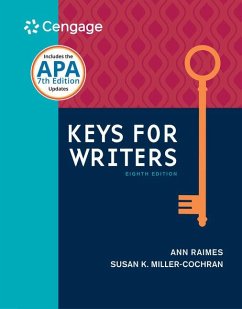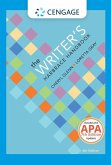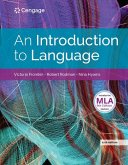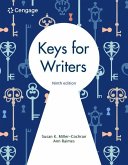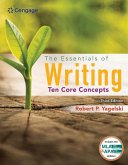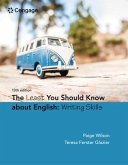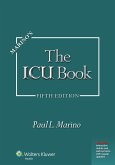Ann Raimes (City University of New York Hunter College), Susan Miller-Cochran (The University of Arizona)
Keys for Writers (W/ Mla9e & Apa7e Updates)
Versandkostenfrei innerhalb Deutschlands
96,99 €
inkl. MwSt.
Versandkostenfrei*
Liefertermin unbestimmt
Melden Sie sich
hier
hier
für den Produktalarm an, um über die Verfügbarkeit des Produkts informiert zu werden.

48 °P sammeln
Ann Raimes (City University of New York Hunter College), Susan Miller-Cochran (The University of Arizona)
Keys for Writers (W/ Mla9e & Apa7e Updates)
- Broschiertes Buch
Offering a wealth of examples, tips, and tools, KEYS FOR WRITERS, 8e, is an easy-to-use resource for improving your writing for all of your coursework -- as well as your career. Color-coded tabs allow you to quickly find answers to your grammar and writing questions. The visual Critical Thinking Framework enables you to read, write, and research with better results, and Key Examples help you compare strong versus weak ways of applying critical thinking. Sample student papers provide excellent models of writing in different disciplines, while the new Assignment Guide provides steps for writing…mehr
Andere Kunden interessierten sich auch für
![The Writer's Harbrace Handbook (W/ Mla9e & Apa7e Updates) The Writer's Harbrace Handbook (W/ Mla9e & Apa7e Updates)]() Loretta Gray (Central Washington University)The Writer's Harbrace Handbook (W/ Mla9e & Apa7e Updates)126,99 €
Loretta Gray (Central Washington University)The Writer's Harbrace Handbook (W/ Mla9e & Apa7e Updates)126,99 €![An Introduction to Language (W/ Mla9e Updates) An Introduction to Language (W/ Mla9e Updates)]() Victoria Fromkin (Los Angeles University of California)An Introduction to Language (W/ Mla9e Updates)104,99 €
Victoria Fromkin (Los Angeles University of California)An Introduction to Language (W/ Mla9e Updates)104,99 €![Grassroots W/ Readings: The Writer's Workbook (W/ Mla9e Updates) Grassroots W/ Readings: The Writer's Workbook (W/ Mla9e Updates)]() Susan Fawcett (Bronx Community College)Grassroots W/ Readings: The Writer's Workbook (W/ Mla9e Updates)108,99 €
Susan Fawcett (Bronx Community College)Grassroots W/ Readings: The Writer's Workbook (W/ Mla9e Updates)108,99 €![Keys for Writers Keys for Writers]() Susan Miller-Cochran (The University of Arizona)Keys for Writers96,99 €
Susan Miller-Cochran (The University of Arizona)Keys for Writers96,99 €![The Essentials of Writing: Ten Core Concepts (W/ Mla9e Update) The Essentials of Writing: Ten Core Concepts (W/ Mla9e Update)]() Robert Yagelski (Albany State University of New York)The Essentials of Writing: Ten Core Concepts (W/ Mla9e Update)89,99 €
Robert Yagelski (Albany State University of New York)The Essentials of Writing: Ten Core Concepts (W/ Mla9e Update)89,99 €![The Least You Should Know About English The Least You Should Know About English]() Paige Wilson (Pasadena City College)The Least You Should Know About English101,99 €
Paige Wilson (Pasadena City College)The Least You Should Know About English101,99 €![Marino's The ICU Book: Print + eBook with Updates Marino's The ICU Book: Print + eBook with Updates]() Paul MarinoMarino's The ICU Book: Print + eBook with Updates78,99 €
Paul MarinoMarino's The ICU Book: Print + eBook with Updates78,99 €-
-
-
Offering a wealth of examples, tips, and tools, KEYS FOR WRITERS, 8e, is an easy-to-use resource for improving your writing for all of your coursework -- as well as your career. Color-coded tabs allow you to quickly find answers to your grammar and writing questions. The visual Critical Thinking Framework enables you to read, write, and research with better results, and Key Examples help you compare strong versus weak ways of applying critical thinking. Sample student papers provide excellent models of writing in different disciplines, while the new Assignment Guide provides steps for writing in 15 common genres you might encounter in your academic and professional career. Completely up to date with the latest MLA guidelines, the eighth edition also highlights the importance of writing in such careers as nursing, accounting, law, IT, and more.
Produktdetails
- Produktdetails
- Verlag: Cengage Learning EMEA / Wadsworth Publishing
- 8. Aufl.
- Seitenzahl: 736
- Erscheinungstermin: 1. Januar 2017
- Englisch
- Abmessung: 199mm x 176mm x 42mm
- Gewicht: 787g
- ISBN-13: 9781305956759
- ISBN-10: 1305956753
- Artikelnr.: 45711990
- Herstellerkennzeichnung
- Libri GmbH
- Europaallee 1
- 36244 Bad Hersfeld
- gpsr@libri.de
- Verlag: Cengage Learning EMEA / Wadsworth Publishing
- 8. Aufl.
- Seitenzahl: 736
- Erscheinungstermin: 1. Januar 2017
- Englisch
- Abmessung: 199mm x 176mm x 42mm
- Gewicht: 787g
- ISBN-13: 9781305956759
- ISBN-10: 1305956753
- Artikelnr.: 45711990
- Herstellerkennzeichnung
- Libri GmbH
- Europaallee 1
- 36244 Bad Hersfeld
- gpsr@libri.de
Ann Raimes, a respected authority on writing, research, grammar and ESL, created the KEYS FOR WRITERS family of handbooks (Cengage Learning) to be the most accessible, user-friendly handbooks available.
Part I: THE WRITING PROCESS. 1. Critical Thinking, Reading, and Writing. 2. Drafting in Stages. 3. Revising, Editing, and Proofreading. 4. Writing and Analyzing Arguments. 5. Writing in Academic Disciplines. ASSIGNMENT GUIDE: KEYS TO COMMON GENRES. Part II: THE RESEARCH PROCESS. 6. Research: A Conversation with Sources. 7. Searching for Sources. 8. How to Evaluate Sources. 9. How to Avoid Plagiarizing. 10. How to Use, Integrate, and Document Sources. Part III: MLA DOCUMENTATION. 11. Citing Sources in Your Paper, MLA Style. 12. MLA List of Works Cited. 13. A Student's Research Paper, MLA Style. Part IV: APA, CSE, AND CHICAGO DOCUMENTATION. 14. Citing Sources in Your Paper, APA Style. 15. APA List of References. 16. A Student's Research Paper, APA Style. 17. CSE Style of Documentation. 18. Excerpt from a Student's Research Paper, CSE Style. 19. Chicago Manual of Style: Endnotes, Footnotes, and Bibliography. 20. Excerpt from a Student's Research Paper, Chicago Style. Part V: DESIGN, MEDIA, AND PRESENTATION. 21. Document Design. 22. Visuals. 23. Online Communication Forums. 24. Oral and Multimedia Presentations. 25. Portfolios. 26. Resumes and Letters of Application. 27. Business Letters and Memos. Part VI: STYLE: THE FIVE C'S. 28. First C: Cut. 29. Second C: Check for Action. 30. Third C: Connect. 31. Fourth C: Commit. 32. Fifth C: Choose the Best Words. 33. Revising for Style: A Student's Drafts. 34. Style Tips. Part VII: COMMON SENTENCE PROBLEMS. 35. Trouble Spots and Terms. 36. Fixing a Sentence Fragment. 37. Run-ons and Comma Splices. 38. Sentence Snarls. 39. Verbs. 40. Passive Voice. 41. Subject-Verb Agreement. 42. Pronouns. 43. Adjectives and Adverbs. 44. Relative Clauses and Relative Pronouns. Part VIII: PUNCTUATION, MECHANICS, AND SPELLING. 45. Commas. 46. Apostrophes. 47. Quotation Marks. 48. Semicolons and Colons. 49. Other Punctuation Marks. 50. Italics/Underlining. 51. Capitalization. 52. Abbreviations. 53. Numbers. 54. Hyphens. 55. Online Guidelines. 56. Spelling. Part IX: WRITING ACROSS LANGUAGES AND CULTURES. 57. Language Diversity and Edited American English: Challenges for Multilingual Writers. 58. Nouns and Articles. 59. Verbs and Verb Forms. 60. Sentence Structure and Word Order. 61. Prepositions and Idioms. 62. Language Learners' FAQs. Part X: GLOSSARIES. 63. Words to Watch For: Glossary of Usage. 64. Glossary of Grammatical Terms. Index.
Part I: THE WRITING PROCESS. 1. Critical Thinking, Reading, and Writing. 2. Drafting in Stages. 3. Revising, Editing, and Proofreading. 4. Writing and Analyzing Arguments. 5. Writing in Academic Disciplines. ASSIGNMENT GUIDE: KEYS TO COMMON GENRES. Part II: THE RESEARCH PROCESS. 6. Research: A Conversation with Sources. 7. Searching for Sources. 8. How to Evaluate Sources. 9. How to Avoid Plagiarizing. 10. How to Use, Integrate, and Document Sources. Part III: MLA DOCUMENTATION. 11. Citing Sources in Your Paper, MLA Style. 12. MLA List of Works Cited. 13. A Student's Research Paper, MLA Style. Part IV: APA, CSE, AND CHICAGO DOCUMENTATION. 14. Citing Sources in Your Paper, APA Style. 15. APA List of References. 16. A Student's Research Paper, APA Style. 17. CSE Style of Documentation. 18. Excerpt from a Student's Research Paper, CSE Style. 19. Chicago Manual of Style: Endnotes, Footnotes, and Bibliography. 20. Excerpt from a Student's Research Paper, Chicago Style. Part V: DESIGN, MEDIA, AND PRESENTATION. 21. Document Design. 22. Visuals. 23. Online Communication Forums. 24. Oral and Multimedia Presentations. 25. Portfolios. 26. Resumes and Letters of Application. 27. Business Letters and Memos. Part VI: STYLE: THE FIVE C'S. 28. First C: Cut. 29. Second C: Check for Action. 30. Third C: Connect. 31. Fourth C: Commit. 32. Fifth C: Choose the Best Words. 33. Revising for Style: A Student's Drafts. 34. Style Tips. Part VII: COMMON SENTENCE PROBLEMS. 35. Trouble Spots and Terms. 36. Fixing a Sentence Fragment. 37. Run-ons and Comma Splices. 38. Sentence Snarls. 39. Verbs. 40. Passive Voice. 41. Subject-Verb Agreement. 42. Pronouns. 43. Adjectives and Adverbs. 44. Relative Clauses and Relative Pronouns. Part VIII: PUNCTUATION, MECHANICS, AND SPELLING. 45. Commas. 46. Apostrophes. 47. Quotation Marks. 48. Semicolons and Colons. 49. Other Punctuation Marks. 50. Italics/Underlining. 51. Capitalization. 52. Abbreviations. 53. Numbers. 54. Hyphens. 55. Online Guidelines. 56. Spelling. Part IX: WRITING ACROSS LANGUAGES AND CULTURES. 57. Language Diversity and Edited American English: Challenges for Multilingual Writers. 58. Nouns and Articles. 59. Verbs and Verb Forms. 60. Sentence Structure and Word Order. 61. Prepositions and Idioms. 62. Language Learners' FAQs. Part X: GLOSSARIES. 63. Words to Watch For: Glossary of Usage. 64. Glossary of Grammatical Terms. Index.
